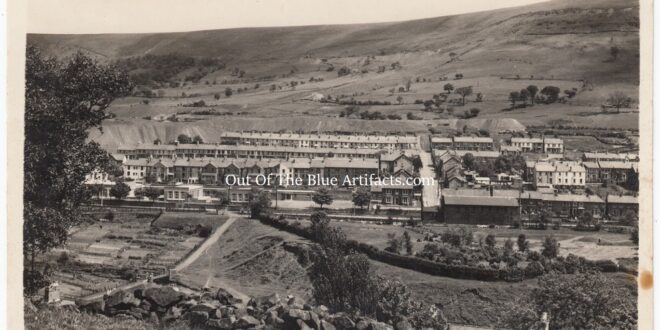The Blue Pilgrims – Blaina.
The Blue Pilgrims were a group of philanthropic ladies based in Kent. Their founder was Beatrice Hankey born 1858, she founded the order in 1902. In 1912 the group went to Staffordshire and aided the miners during the strike and throughout the Great War they set up home huts near army barracks for refreshment and prayers. During the 1920’s depression they went back to Staffordshire and made a visit to South Wales. The order set up a small base at Llantwit Major, it was there that they met with Rev R. J. Barker and asked him what good could they do in South Wales, he replied “Go to a place called Blaina in Monmouthshire”. The group made arrangements and visited the area to see what aid they could give to the people of the Nantyglo and Blaina district.
The Blue Pilgrims, although many were wealthy titled ladies, within the group were known by spirit names, this was a sign of belonging to the group and enforced no class barriers. Some of the ladies who came to Blaina and Nantyglo will be referred to by such names in the following report and at the bottom of the page all their adopted spirit names will be listed.
The Blue Pilgrims at Blaina.
They came to Blaina in March 1928 to help ease the peoples suffering during the industrial depression. During their stay they rendered great charitable help and friendship to the distressed people of Blaina and assisted the local Juvenile Unemployment Training Centre. Each week they held small social gatherings at the Wesleyan School Room. The Blue Pilgrims provided the local training centre for boys a quantity of leather for boot repairing and also gave two valuable books for an essay competition. This competition was said to have proved a great success and the winners were Mr Elvet Wetherall and Mr A. Nicholas. The presentations were made on Wednesday 21st March 1928 by Pilgrim Inheritance. It was announced that the Blue Pilgrims were to leave Blaina at the end of March though would return in August of that same year.
After their initial visit to Blaina, the founder of the order, Beatrice Hankey employed a Blaina man by the name of Mr Richard John Richards, son of Mr and Mrs Richard Richards of 27 Cwmcelyn Road Blaina to tend to her residence “The Chantry” at Sevenoaks, Kent.
It seems as though the Blue Pilgrims made a return visit to the district even earlier than announced as in May 1928 the South Wales Gazette reported on their arrival at Blaina and their invaluable help in the setting up of soup kitchens at Blaina and Cwmcelyn and one at Nantyglo. They provided, at their own expense food and entertainment for the local boys at the training centre and also supplied them with leather to repair boots and have found situations for women, girls and youths from the district. In late May they gave free teas at the Garn Primitive Methodist Church and distributed shilling packets of seeds to the large number of unemployed to enable them to plant in their gardens. The pilgrims left Blaina just after, though promised to return.
On Friday 7th of September 1928, the Blue Pilgrims came back to Blaina, Pilgrim Help the foundress of the order lead the group and was assisted by nine other pilgrims who organised meetings for the men and women. The group organised a Flower & Vegetable Show held at the Church Institute, a Sports Competition at the park and many religious services at various churches in the area.
On Friday 21st of September 1928, after a few months in Blaina the Blue Pilgrims conducted their final meeting at the Wesleyan Church. The meeting was conducted by Pilgrim Help, the foundress of the order. Mr B. Hillier secretary of the Allotments Society gave Pilgrim Help a large photograph of the band of pilgrims as a token of esteem for the good work they had done in the locality. At this meeting it was announced that the Blue Pilgrims had purchased Brynllifrith House at Nelson as a rest home for the pilgrims and as a base to visit this area other than from their Kent home.
In November 1928 the Blue Pilgrims lead by Pilgrim Help came back to Blaina to continue their philanthropic work. They set up many meetings at the Wesleyan Church and the Salem Baptist Church and spent all their time visiting the sick and those in need. During this visit they did a canvass of the area which gave them an idea of who needed the most help, they did a similar canvass which enabled them to give clothing and blankets to the neediest.
It was later reported that they distributed 3 yards of flannel to over a thousand applicants, the distribution had to cease as supplies run out.
On Wednesday 30th of January 1929, at a public meeting, held at the Blaina Central School the first of a series of three such gatherings in connection with the Nantyglo and Blaina Relief Fund, Mr H. Ashton chairman of the Nantyglo and Blaina District Council explained how the Willesden Relief Fund inaugurated through the adoption of Blaina by the Willesden had been administered. Capt. E. Silk M.A. LL.B. stated that every unemployed man had received a voucher for the sum of 5s. or 7s. 6d. with the exception of those who had received parcels from the Blue Pilgrims. Willesden instructed the Blaina Council that all future allocations of money must be used in the provision of work with the object of enabling unemployed persons to secure sufficient stamps on their insurance cards to entitle them to benefits.
Mr Silk explained that £265 had been given in vouchers, 278 parcels had been distributed to large families, clothing outfits had been given to 75 men who had left the district to obtain work elsewhere, old age pensioners had been given 104 pairs of trousers and 98 overcoats, 85 pairs of boots were distributed and roofing slates valued at over £100 had been donated by a Newport firm of builders to be shared among people whose houses had been damaged by the recent storm.
Alderman W. Dunn paid a tribute to the residents of Willesden for their self-sacrificing assistance. He stated the sick and the aged would be assisted by the Lord Mayors Fund and that the Blue Pilgrims would in future co-operate with the council in the relief of distress, in which he heaped praise on the excellent work accomplished by the beneficent ladies.
On Friday 15th of February 1929, it was announced the Blue Pilgrims had provided a skilled nurse for the Blaina district and that she was keeping busy visiting the sick, elderly and those in need. The group also opened Church Institute to the public, for them to go in for a warm, lit a large fire and made cocoa and cake which was provided free, they also distributed flannel and blankets.
The Pilgrim’s Garden.
On Monday 29th of April 1929, at an annual meeting of the Nantyglo and Blaina Council, the following members attended – Mr H. Ashton; Mr L. Chaffey; Mr C. Fear; Mr E. Cousins; Mr J. Chard; Mr T. W. Hale; Mr E. Silk M.A. LL.B.; Mr A. Sharrem; Mr W. Lloyd; Mr T. Jones; Mr E. Lewis; Mr E. Evans; Mr J. L. Adams; Mr L. A. Wallen (Clerk); Mr E. J. Helt (Assistant Clerk); Mr J. M. Job (Surveyor) and Mr W. Beynon (Rating Officer): The Clerk Mr L. A. Wallen stated that several letter were received from the Blue Pilgrims. The chief matter mentioned was a proposal to convert the ash tip on the Duffryn into a playground. The clerk said the only hurdle would be getting a man to look after the ground. He suggested to the pilgrims that they might want to take a portion of the ground by the Blaina Institute so as the caretaker of which could look after it. The pilgrims replied that they would take that ground as well as the ash tip, Mr Sharrem invited the Blue Pilgrims to the council chamber to discuss the matter mentioned.
In late May 1929 the Blue Pilgrims had succeeded in acquiring the old ash tip called the Crown Tip in readiness for its transformation. The Nantyglo and Blaina Ironworks Company through their solicitor Mr Edward Coulman and the local agent Mr Jenkin Jenkins were displaying a keen interest in the project. A local committee was set up to co-operate and aid the band of Blue Pilgrims with their scheme. The committee members were as follows – Mr D. J. Thomas (Chairman); Mr W. Cole (Treasurer); Mr Ben Lewis (Secretary); Mr Joseph Pierce (Supervisor); Mr C. M. Jones (Labour Exchange); Mr Ben Morgan; Mr Alfred Evans; Mr Tom Huggins; Mr D. Howell Griffiths and Miss E. Athay. The ground was to be known as the Pilgrims Garden.
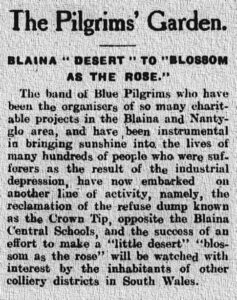 In June 1929 it was reported in the South Wales Gazette (as seen right) headlined “The Pilgrims Garden, Blaina Desert to Blossom as the Rose” that the band of Blue Pilgrims who had been organisers of so many charitable projects in the Blaina and Nantyglo area had been instrumental in bringing sunshine into the lives of so many people who were suffering from the effects of the industrial depression had embarked on a new activity, the reclamation of the refuse dump known as the Crown Tip opposite the Central Schools, Blaina has been in progress for a month. Altogether 3 acres of land had been fenced in, shrubs, trees and rock garden flowers will be planted. Their aim is to make it an attractive place of recreation and rest for aged people. There was to be space reserved for little children for whom a sandpit, shelter and other devices and amusements were planned.
In June 1929 it was reported in the South Wales Gazette (as seen right) headlined “The Pilgrims Garden, Blaina Desert to Blossom as the Rose” that the band of Blue Pilgrims who had been organisers of so many charitable projects in the Blaina and Nantyglo area had been instrumental in bringing sunshine into the lives of so many people who were suffering from the effects of the industrial depression had embarked on a new activity, the reclamation of the refuse dump known as the Crown Tip opposite the Central Schools, Blaina has been in progress for a month. Altogether 3 acres of land had been fenced in, shrubs, trees and rock garden flowers will be planted. Their aim is to make it an attractive place of recreation and rest for aged people. There was to be space reserved for little children for whom a sandpit, shelter and other devices and amusements were planned.
The project attracted expert and professional advice from specialists in designing and cultivation and among those who had rendered their services were Mr Alwyn Lloyd F.R.I.B.A. of Cardiff; Mr H. G. Purvis the Principal of the Monmouthshire Agricultural College; Mr G. Bevan, lecturer at the same college and Mr Hoskins, surveyor to the Ebbw Vale Council. The labour was to be given freely by the unemployed men who had been working on the reclamation for a few days per week over the past month when the project started.
During the late 1920’s and through the early 1930’s the Blue Pilgrims were visiting Blaina regularly and in 1930 made the Drill Hall at West Side, Blaina a part of their headquarters where they held functions and many meetings.
The Pilgrim Park Gates.
In July 1929 it was reported in the South Wales Gazette that the Nantyglo and Blaina Iron Company Ltd had gifted the iron gates from Mr Crawshay Bailey’s residence Nantyglo House to the Park Committee and was to be fixed in position shortly.
On Tuesday 20th of May 1930, a function was held at the Drill Hall by the Blaina Athletic Club. The report stated that the club had been inaugurated by the Blue Pilgrims for the welfare of the young girls and boys of Blaina and the Instructor was Mr Chris Emery. The Nantyglo contingent was united to the Blaina club and there were 82 members. After the meal a musical display was held. There were many people in attendance, too many to list, though if anyone want any information for family history etc please ask and I will supply any relevant names or information.
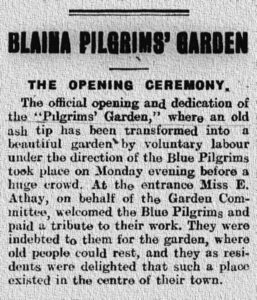 The Official Opening of the Pilgrim’s Garden.
The Official Opening of the Pilgrim’s Garden.
On Monday 30th of June 1930, the Pilgrim’s Garden was officially opened. The report (as seen left) stated that the old ash tip known as the Crown Tip had been transformed into a beautiful Garden (as seen in the featured image above) by voluntary labour under the direction of the Blue Pilgrims. On the Monday evening at the entrance of the garden Miss E. Athay on behalf of the Garden Committee welcomed the Blue Pilgrims and paid tribute to their work. Pilgrim Help the foundress of the order, in the presence of a huge crowd unlocked the gate. Once inside the garden Pilgrim Help presided and the proceedings commenced with singing “O God Our Help in Ages Past” accompanied by the Salvation Army Band under the leadership of the Bandmaster Mr S. Vaughan.
Pilgrim Help spoke of how proud they were to have transformed the old ash tip into a lovely garden and stated the idea to do so first came from Pilgrim Inheritance and now it had materialised she hoped that good use would be made of the garden as a place of rest for the old and invalid. Pilgrim Inheritance said, “The garden stood for three great things, Faith, Hope and Love”. “By those three qualities an old ash tip had been transformed into a thing of beauty”.
The Rev R. J. Barker the Wesleyan Minister of Tonypandy spoke of how he had suggested that the Blue Pilgrims come to Blaina in the first place. At a meeting a few years ago the Blue Pilgrims foundress, Pilgrim Help asked him what good could she do in South Wales, he replied “Go to Blaina”. From that meeting their work in this district started. Reverend W. T. Davies said that he hoped foul language would not be used in the garden, for the sake of the children. He had heard less foul language in Blaina than any other place he had visited. Mr Bush voted of thanks to the workmen and appealed for subscriptions in order that a shelter be provided in the garden. The Reverend R. J. Barker offered prayer and the memorable evening ended with the hymn “Abide With Me”.
On Sunday 13th of July 1930, the Blaina Athletic Club, which was formed by the Blue Pilgrims as mentioned, held their first religious open-air meeting in the Pilgrim’s Garden. Rev W. T. Davies of the Gobaith Church gave an inspiring address.
In September 1930 it was announced that gifts of park benches form placement at the gardens had been received from various organisations. Some churches gifted them with one bearing the inscription “From the residents of Brynteg” another one was sent from the Bible Class at Cardiff and there was one with the inscription “A token of goodwill from the people of Farnham to the people of Blaina”. Several trees on the site and many flowers were also gifts.
In July 1931 the Blue Pilgrims sent a group of men from Blaina, Nantyglo, Brynmawr, Clydach and Gilwern camping for nine days at Llangasty near Llangorse. The Blue Pilgrims also arranged for more than fifty London children to stay at Blaina. They were boarded by various residents in the area. Mr Sidney and Mrs Florrie Bush of 35 Bournville Road, Blaina were the organisers for the accommodation of the hundreds of the London children who had been given holidays in the Blaina area under the auspices of the Blue Pilgrims. Mrs Bush was the daughter of Mr Thomas Gane of Bournville, Blaina.
In August 1931 the Pilgrim’s Garden had been transformed by the addition of a Recreation Ground and a Green had been laid out. The Garden Committee had provided an 18 hole Putting Green and also a Bowling Green which included 14 sets.
On Thursday 26th of November 1931, the Blue Pilgrims announced that they had made another addition to their many branches of activities in the district when they purchased a property at Blaina which would become “The Campers and Pilgrims Home”. The premises was originally known as the corner shop with a house adjoined at the bottom of High Street, Blaina. Pilgrim Help had a meeting with the Nantyglo and Blaina Estates Ltd in connection with the damage to the foundations of the Pilgrim’s Garden during the recent flooding. She suggested that a five-foot concrete wall to be built around the base of the garden to prevent further damage. She asked for volunteers and said the work would take four to five weeks and several people offered their help with the construction of the wall.
The Duke and Duchess of York.
On Thursday 17th of March 1932, the Duke and Duchess of York came to Blaina to officially open the new maternity wing at the Nantyglo and Blaina Hospital. During their visit to the area they inspected the Pilgrim’s Home on High Street, Blaina in the presence of Pilgrim Reposeful and they also toured the Pilgrim’s Garden.
In June 1932 under the auspices of the Blue Pilgrims, 20 women from Blaina and 20 women from Nantyglo were sent for a week’s camping to Ham Court at Llantwit Major, a huge mansion which the Blue Pilgrims had secured for such purpose. It was stated that 20 women from the district had been there previously and it was arranged to send more.
In August 1932 It was reported that Pilgrim Help, foundress of the order had been taken seriously ill at her home in Sevenoaks, Kent. The Blue Pilgrims announced that they had taken over the premises known as the Foresters Arms in High Street, Blaina and the King William the IV at Queen Street, Nantyglo as homes for the campers. The following officers were elected – Mr P. Harris, local Wesleyan Preacher (Chairman); Mr John Jones (Vice Chairman); Mr Hockaway? (Treasurer) and Mr F. W. Hughes (General Secretary):
The Death of Beatrice Hankey 1858-1933.
On Monday 6th of February 1933, at a monthly meeting of the committee and collectors of the Blaina and District Nursing Association the chairman announced the sad death of Pilgrim Help, the foundress of the Blue Pilgrim’s at her residence Chantry at Sevenoaks in Kent. It was decided that a vote of sympathy be sent to Pilgrim Inheritance. It was reported that Pilgrim Help’s real name was Beatrice Hankey, sister of the late Justice Hankey. She had formed the Blue Pilgrims in about 1902 and had gathered around her several prominent assistants, mostly women, some were titled ladies. Their policy was to create activity in distressed areas. Mrs Hankey was also responsible for the setting up of the Nursing Association in the district.
On Thursday 9th of February 1933, the funeral of Beatrice Hanky – Pilgrim Help took place at the cemetery at Sevenoaks. At the same time a memorial service took place at the Blue Pilgrims Home at Blaina. The service at Blaina was conducted by Rev W. T. Davies and poems was read by Pilgrim Fragrance who had travelled from Dowlais. Rev J. Towns read a lesson and later Pilgrim Helps favourite hymns were sung “Abide With Me” and “Hallelujah Song”, the services were concluded with the Lord’s Prayer. It was stated that Pilgrim Inheritance will succeed the late Pilgrim Help.
On Sunday 4th of February 1934, to commemorate the anniversary of the death of Beatrice Hanky. Pilgrim Help who died last year, a memorial service was held at the Home Camp, Blaina. Pilgrim Desire conducted the service and was supported by Pilgrim Francis and officers of the Home Camp. Mr L. Savio read the lesson and the founders’ favourite hymns were sung. The accompanist was Miss Millie Symonds. A similar service was held the same evening at the Good Neighbour’s Club, Nantyglo and was conducted by Pilgrim Evangel and Pilgrim Burden Bearer.
In August 1934 it was reported that through the organisation of the Blue Pilgrims a number of London school children were on holidays in the district and were being boarded out at homes at the rate of 10s. shillings each.
In January 1935 new officers for the Blaina Blue Pilgrims Home Camp were elected, they were as follows – Mr A. Ball (Chairman); Mr Bert Tilley (Secretary) and Mr Sid Elkins (Treasurer): It was stated that as one half of the committee retired each year, ten new members were elected.
On Thursday 25th of July 1935, a meeting of the Abertillery Jubilee Nursing Association took place to report on the progress made in obtaining subscribers to the Nursing Association Funds. A small section of the list headed by the Blue Pilgrims Organisation with a donation of £50.
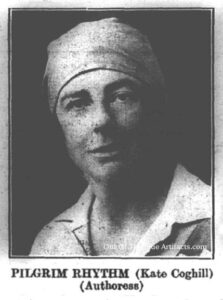 The Blaina Peace Pageant.
The Blaina Peace Pageant.
In February 1936 it was reported in the South Wales Gazette that there were two events being organised for Easter Monday and Tuesday, a fete and gala and a pageant to be staged at the Duffryn Field in early June. The pageant was the inception of Pilgrim Rhythm (Miss Kate Coghill) (as seen in the image right) who had written the scenarios and was backed by the Blue Pilgrims to whom Blaina owed so much already. The Blue Pilgrims supplied the material to clothe and bedeck the 1,500 performers at their own expense. Some of the people who were involved with the production were as follows – Mr David Harris; Mr Wilfred Jones; Mr W. L. Hoskins; Councillor T. Hale; Miss May Macdonald Taylor; Mr Ben Evans; Mrs Beryl Jones; Mr A. Ball; Mrs B. Lawrence; Mr T. T. Williams and Alderman W. H. Jones; Miss I. O’Leary M.A.; Miss E. H. Lewis B.A.; Mrs Hilda Evans; Mr Billy Jones; Mr J. Probert; Mr R. Drew; Mr Ellis Jones and Miss G. E. Jenkins:
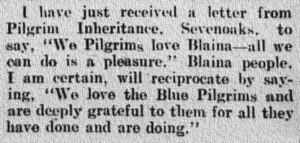 It was during the printing of this report that the South Wales Gazette published this letter from Pilgrim Inheritance written from her home at Sevenoaks, Kent, dated February 1936.
It was during the printing of this report that the South Wales Gazette published this letter from Pilgrim Inheritance written from her home at Sevenoaks, Kent, dated February 1936.
In June 1936 the planned pageant to have been held on the Duffryn Field was postponed for a month owing to the failure to produce the many costumes needed for the show. It was announced that the scene managers under the direction of Miss Dorothy Quirk was busy rehearsing and will now be ready for the show to take place in the middle of July. The pageant was to be opened by the famous Australian born film star Miss Betty Stockfield, who had Welsh ancestry. Miss Stockfield’s visit was courtesy of Mr J. Woolf, General Film Distributors Ltd, 127-133 Wardour Street, London W.1. She was under contract to a French film company with which she was filming though they told her they would postpone production for her to open the show at Blaina. The Blaina Pageant’s producer Miss Dorothy Vincent Quirk resided at 68 Bridge Street, Newport.
On Friday and Saturday 17th and 18th of July the Blaina Pageant did not go ahead as planned as of the adverse weather conditions. A large crowd turned out at the Duffryn Field and Miss Betty Stockfield attended and presided over the opening ceremony though heavy rain and thunderstorms prevented the show from commencing. It was announced that the pageant would be postponed until September 23rd, 25th and 26th. Later a letter was read from Miss Betty Stockwell in which she wrote “Had enjoyed her time in Blaina, she had visited the Nantyglo & Blaina Hospital, talked to an old miner who was recovering from a broken leg he had received in a colliery accident. She also hoped that the re-arranged pageant would be a great success” and said she would be back to visit Blaina to do some mountain climbing.
In September 1936 a Character Jazz Band was formed in Blaina. The officers were as follows – Mr John Jones (President): Pilgrim Rhythm, Miss Kate Coghill (Vice President); Mr J. Fleming (Chairman); Mr H. Teague (Vice Chairman); Mr T. Evans (Treasurer) and Mr W. Williams (Secretary) of 2 Railway Terrace, Blaina.
On Wednesday 23rd of September 1936, the Blaina Pageant at the Duffryn Field finally went ahead. It had been postponed on a few occasions as mentioned, though the weather had settled and as many people had travelled from London and the Rhondda Valley, South Wales the pageant was officially opened by Mrs Douglas Coghill, Pilgrim Rhythm, (Miss Kate Coghill’s) mother.
The main show on the Duffryn Field would be followed by other shows on Friday 25th for the children of South Wales and Monmouthshire and Saturday evening 26th September will be another performance. The officers for the pageant were as follows – Mr A. Ball (Chairman); Alderman W. H. Jones (Organising Secretary); Miss A. Parkes (Treasurer); Mr J. Probert (Musical Director); Mrs Hilda Evans (Dress Designer); Mr C. Ford-Dunn (Historical Designer); Miss I. O’Leary M.A., (Historical Adviser); Mr M. Thomas and Mr R. Drew (Property Designers); Mr Billy Jones (Scenery Designer) and Mr Eddie Williams B.Sc., (London) F.R.G.S.; Miss Dorothy Vincent Quirk (Pageant Producer); Councillor T. Hale, Miss M. Macdonald Taylor, Mr Ben Evans, Mr W. L. Hoskins B.A.,Miss I. O’Leary M.A., Miss E. H. Lewis B.A., Mrs Beryl Jones, Mr Albert Ball, Mr Ellis Jones, Mr T. T. Williams, Miss G. Jenkins (Scene Producers); Pilgrim Rhythm, Miss Kate Coghill (Authoress) and the promoters were The Blue Pilgrims:
On Friday 30th of October 1936, Pilgrim Rhythm (Kate Coghill) the authoress and organiser of the Blaina Peace Pageant that had been held in September along with Miss A. Parkes the treasurer and Mr Albert Ball the chairman, on behalf of the Pageant Committee attended as a deputation and handed over a cheque of £150, equivalent to £9,780 in today’s money, the proceeds of the pageant to the Nantyglo and Blaina Hospital Fund.
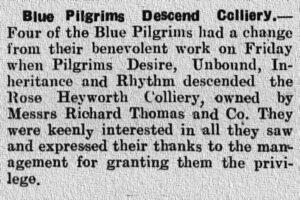 In November 1936 four of the Blue Pilgrims – Pilgrim’s Inheritance, Rhythm, Desire and Unbound descended Rose Heyworth Colliery (as seen in the report right) for an underground pit visit.
In November 1936 four of the Blue Pilgrims – Pilgrim’s Inheritance, Rhythm, Desire and Unbound descended Rose Heyworth Colliery (as seen in the report right) for an underground pit visit.
On Thursday 4th of February 1937, a Blaina Pageant Supper was held at the Gladstone Street Methodist Church. At the entertainment Mr A. Ball the chairman, presided. Alderman W. H. Jones J.P. the secretary presented Miss Dorothy Quirk, the producer with a tapestry piano stool on behalf of the Pageant Committee. On behalf of the Blue Pilgrims, Pilgrim Rhythm presented the chairman Mr A. Ball and the secretary Alderman Jones with a gold fountain pen each for their services. The ladies who attended to the tables were as follows – Pilgrim Rhythm; Mrs Sainsbury; Mrs Derrick; Mrs James; Mrs Hockaway?; Mrs Edmunds and Mrs Griffiths: Miss P. Bainton; Miss M. Marshman; Miss E. Green and Miss G. James:
In the late 1930’s the reports on the Blue Pilgrims at Blaina and Nantyglo started to lessen, the camping trips were still being organised and well attended, Pilgrim Rhythm opened a few local shows yet there were no other activities mentioned in the local newspapers. I am not sure when the Blue Pilgrims left the district though their hard work, dedication and devotion shown to the people of Nantyglo and Blaina should never be forgotten.
The main image above is – Copyright the Francis Frith Collection.
Points of Interest – The Blue Pilgrims, although many were wealthy titled ladies, within the group were known by spirit names this was a sign of belonging to the group and enforced no class barriers. Below is a list of some of the ladies’ spirit names who featured in the many projects funded by the Blue Pilgrims at Blaina and Nantyglo.
Pilgrim Help, real name Beatrice Hankey. Originally from Walmer, Kent, later she resided at The Chantry, Sevenoaks, Kent.
Pilgrim Inheritance, real name Miss L. Bridge residence The Chantry, Sevenoaks, Kent
Pilgrim Rhythm, real name Miss Kate Coghill, daughter of Mr and Mrs Douglas Coghill, residence No14 Stanhope Gardens, London S.W.7.
Pilgrim Rescuer, real name Mrs Haslewood.
The other pilgrims – Pilgrim Sincerity; Pilgrim Fragrance; Pilgrim Trustful; Pilgrim Balm; Pilgrim Burden Bearer; Pilgrim Fulfiller; Pilgrim Friendly; Pilgrim Reposeful; Pilgrim Excelsior; Pilgrim Desire; Pilgrim Charity; Pilgrim Serene; Pilgrim Mountaineer; Pilgrim Runner; Pilgrim Steadfastness; Pilgrim Openheart; Pilgrim Ardour; Pilgrim Unbound; Pilgrim Goldenheart; Pilgrim Evangel; Pilgrim Francis; Pilgrim Joybell and Pilgrim Seabird:
The Blue Pilgrims were in the area helping the distressed in their time of trouble, it seems, reading the old reports that Pilgrim Help, Beatrice Hankey the founder of the Order was the organiser at Blaina, aided by Pilgrim Inheritance and many other pilgrims on a rota basis. Pilgrim Rhythm was originally in charge of the Dowlais area until she was posted to Blaina, while Pilgrim Welcome was at Six Bells, Abertillery (Even though the organisation were in Abertillery in the 1930’s and they did offer to supply a nurse for the area I cannot find any information on their visit and base other than Pilgrim Rescuer was mentioned as being in negotiations for the Blue Pilgrims with the council in the Abertillery district).
Whilst researching the Blue Pilgrims story I found an interesting report from the South Wales Gazette from August 1936 in which a little boy by the name of Master Ivor James Powell the four-year-old son of Mr and Mrs G. Powell of Abertillery Road, Blaina was fishing at the South Griffin Feeder Pond. He was running along the bank when he fell into the water, his sister aged eight jumped in in an attempt to rescue him. The sides of the feeder pond were said to have been bricked and the little girl while trying to keep her little brother afloat could not get a foothold to get her brother and herself out of the water and she began to struggle, before long both were in difficulty.
At this point a young boy by the name of Master George Page aged ten, from London, though who had been staying in Blaina under the auspices of the Blue Pilgrims saw the youngster’s plight, jumped in and saved them both from certain drowning. It was reported that the drama had been watched by a few adults who were “helpless witnesses” as they were the other side of the feeder and couldn’t assist. The young George Page after being congratulated said “I am glad I learnt to swim at St Luke’s School, Canning Town, London and that I was there to help them out”. I personally feel it was fate that he had to be there on holiday arranged by the Blue Pilgrims to save the lives of two young children from Blaina.
 Out Of The Blue Artifacts A Library of a lifetime of collecting
Out Of The Blue Artifacts A Library of a lifetime of collecting
